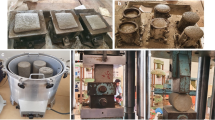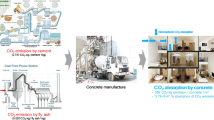Abstract
Environmental issues related to CO2 emissions have become a key focus for many different industries, including the cement and concrete industry. An environmentally optimized ‘green’ concrete can provide a much needed alternative to conventional concrete to reduce the carbon footprint of the construction industry. This can be achieved through high Portland cement replacement by fly ash and with the inclusion of activators to enhance the rate of development of strength and other properties. This study evaluates different fly ashes and different activators (Na2SO4, lime and quicklime) that are added to enhance the reaction of the fly ash to achieve a comparable performance to that of standard Portland cement in mixes of much lower CO2 emissions. TGA, XRD and SEM are used to determine the development of hydration products and the consumption of portlandite by the fly ash. It is found that the amorphous content of the fly ash is an important parameter influencing compressive strength evolution. Based on the results, Na2SO4 as an activator, and a fly ash with high reactive SiO2 and Al2O3 contents and low Fe2O3 are found to provide the best options for producing a high volume fly ash matrix with the potential to show comparable behavior to a Portland cement control mix.
Access provided by CONRICYT-eBooks. Download chapter PDF
Similar content being viewed by others
Keywords
8.1 Introduction
In recent years, different possible solutions to reduce the carbon footprint of concrete have been studied by cement and concrete researchers [1,2,3,4,5,6,7,8,9,10,11,12,13]. One of the solutions put forward is the inclusion of supplementary cementitious materials in high percentages for concrete production [2, 3]. To advance this concept, all important parameters need to be optimized to develop an optimum green concrete (UOGC) as a low CO2 concrete alternative for the construction industry. The UOGC, investigated in this work, is based on a high volume fly ash concrete (HVFA ) , with added alkaline activators. Although this technology has been explored before [4], there are still many unanswered questions [5] which relate to why it has never yet been produced in sufficient volumes to compete with regular Portland cement concrete. Lack of detailed technical information, standards, and the evident need to further research its fresh and hardened properties and durability [6] are some of the reasons motivating further work aimed to explore and develop answers regarding its real viability.
In this study, which is primarily of a scoping nature, mortars and pastes will be evaluated including different activators (sodium sulfate, lime and quicklime) and different high loss on ignition (LOI ) fly ashes . Based on compressive strength, X-ray fluorescence (XRF) , X-ray diffraction (XRD) , thermogravimetry and scanning electron microscopy (SEM) analysis , the preferred activator and its optimum dosage will be determined.
8.2 Experimental Details
Fly ashes (FA) included in this study are referenced as TP FA , FB FA , TG FA and TA FA ; the main difference between them is that TP FA, FB FA and TG FA include a high LOI content, while TA FA has a low content. Initially each fly ash was sieved in order to see the effect of the fineness increment and the variations of their compositions. After that, mortar and pastes were produced including different activator dosages with each fly ash, a Type III cement (ASTM C 150) and considering as constant the water to cementitious material ratio.
A PANalytical Axios sequential wavelength dispersive XRF (WDXRF) was used to obtain the chemical composition of each different fly ash. Furthermore, a PANalytical (X’PERT-PRO MPD) system was used for the fly ash mineralogical XRD evaluation. In order to determine the amorphous content, the Rietveld method was followed, using rutile as the internal standard. For mortar mixes, most of the standard ASTM C 109 procedure was followed, with some additional considerations about the mixing of materials; all of the activators were always added to water and mixed before adding the cementitious materials. As expected in this process, quicklime was the only material which increased the temperature significantly. Portlandite was quantified using thermogravimetry analysis and considering the mass change between 450 and 550 °C.
Table 8.1 presents how different codes describing mix design parameters are organized in the mix IDs throughout this study. It is necessary to use the codes and mix IDs due to the number of parameters evaluated in this work.
8.3 Results and Discussion
Paya et al. mentioned how the reactivity of fly ash increased by improving its fineness [7]. In this study and according to the results shown in Fig. 8.1, the amorphous content of fly ash has a strong influence on the compressive strength. By improving fly ash fineness its composition was changed; Table 8.2 summarizes the effect of the sieving process on the main parameters of each ash . The amorphous, silica and LOI contents were different for each fineness in each case. Figure 8.1 shows that the compressive strength of mortar samples with 20% of fly ash was improved when the amorphous content increased. According to Duran, the compressive strength decreases by increasing the LOI content [3], but in the present study there were some unexpected tendencies where even when the particle size and the LOI content decreased, the compressive strength decreased and it was due because the amorphous content was lower. At some point, fly ashes would not need a mechanical treatment based on the initial amorphous content.
Considering the interaction with activators at different dosages, TP FA had the best performance with sodium sulfate at a dosage of 1%; according to Fig. 8.2a, compressive strength increased about 40% compared to the sample without activator. Qian et al. evaluated the effectiveness of this activator with HVFA mixes and found that Na2SO4 reacts directly over the Ca(OH)2, increasing the alkalinity and accelerating fly ash dissolution ; SO4 increases the formation of ettringite, affecting the density of the mortar matrix positively [8]. The XRD results show that sodium sulfate addition led to the formation of more ettringite than the other activators, improving the strength of this mix.
Sodium sulfate was the activator which presented the best performance using different fly ashes. The influence of fly ashes was also relevant; for instance, FB FA and TP FA were the most reactive for this activator (Fig. 8.2b). The compressive strength performance was the first indicator of their effectiveness. Initially it was expected that TA fly ash would have the best performance in the presence of activators due to its low LOI, but TA did not react as well as FB FA , as presented in Fig. 8.2b; this is possibly due to the high Fe2O3 content, which reduced the speed of dissolution of the reactive components of fly ash. Fernandez-Jiménez and Palomo presented some results with high Fe2O3 content in fly ash; Fe2O3 did not appear in the products of the main reactions [9]. On the other hand, FB fly ash had the lowest Fe2O3 content and one of the highest compressive strength values using sodium sulfate (Fig. 8.2b).
Portlandite consumption in mixes with sodium sulfate and 50% of TP FA started after 3 days of age, compared to mixes with FB FA at 7 days. Figure 8.3 shows that the portlandite content of mixes with TG FA and TA FA kept increasing at 28 days.
Ettringite and the amorphous content calculated with XRD were coherent with the compressive strength evolution; at the first days the formation of ettringite helped to improve the compressive strength, and at later ages the formation of C-S-H increased, part of it included in the amorphous content, as presented in Table 8.3.
Figure 8.4 shows SEM images of gypsum , ettringite and C-S-H formation on the surface of TP FA at different ages.
8.4 Conclusions
The addition of sodium sulfate to high volume fly ash-Portland cement binders increases ettringite formation and portlandite consumption; these characteristics were evident in the compressive strength evolution, thermogravimetry and XRD results; on the other hand, quicklime and lime did not present any positive effect in the activation process.
Initially it was evident that a high amorphous content in the fly ash could help to increase the compressive strength in mixes without activators. After considering mixes with activators, the influence of the fly ash Fe2O3 was also relevant, as was evident with high Fe2O3 fly ashes, where it seems that the speed of dissolution of the fly ash decreased affecting the activation process negatively. These results provide initial steps toward the design and optimization of hybrid high-volume fly ash Portland cement-alkaline cements and mortars, aiming towards the development of Ultra-Optimum Green Concrete for sustainable development in the construction industry.
References
Pade C, Guimaraes M (2007). The CO2 uptake of concrete in a 100 year perspective. Cem Concr Res 37:1348
Malhotra VM (2002). High-performance, high-volume fly ash concrete. Concr Int 24:30
Atiş CD (2005). Strength properties of high volume fly ash roller compacted and workable concrete, and influence of curing condition. Cem Concr Res 35:1112
Palomo A, Grutzeck MW, Blanco MT (1999). Alkali-activated fly ashes. A cement for the future Cem Concr Res 29:1323
Pacheco-Torgal F, Abdollahnejad Z, Camoes AF, Jamshidi M, Ding Y (2012). Durability of alkali-activated binders: A clear advantage over Portland cement or an unproven issue? Const Building Mat 30:400
Shi C, Fernández-Jimenez A, Palomo A (2011). New cements for the 21st century: The pursuit of an alternative to Portland cement. Cem Concr Res 41:750
Paya J, Monzó J, Borrachero MV, Peris-Mora E, Gonzalez-Lopez E (1997). Mechanical treatment of fly ashes. Part III: Studies on strength development of ground fly ashes (GFA) – cement mortars. Cem Concr Res 27:1365
Qian J, Shi C, Wang Z (2001). Activation of blended cements containing fly ash. Cement and Concrete Research. Cem Concr Res 31:1121
Fernández-Jimenez A, Palomo A (2003). Characterization of fly ashes. Potential reactivity as alkaline cements. Fuel 82:2259
Criado M, Palomo A, Fernández-Jimenez A (2005). Characterization of fly ashes. Potential reactivity as alkaline cements, Fuel 84:2048
Poon C, Kou S, Lam L, Lin Z (2001). Activation of fly ash/cement using calcium sulfate anhydrite (CaSO4). Cem Concr Res 31:873
Lee CY, Lee HK, Lee KM (2003). Strength and microstructural of chemically activated fly ash-cement systems. Cem Concr Res 33:425
Antiohos S, Papageorgiou A, Papadakis V, Tsimas S (2007). Influence of quicklime addition on the mechanical properties and hydration degree of blended cements containing different fly ashes. Const Building Mat 22:1191
Author information
Authors and Affiliations
Corresponding author
Editor information
Editors and Affiliations
Rights and permissions
Copyright information
© 2017 Springer International Publishing AG
About this chapter
Cite this chapter
Velandia, D.F., Lynsdale, C.J., Ramirez, F., Provis, J.L., Hermida, G., Gomez, A.C. (2017). Optimum Green Concrete Using Different High Volume Fly Ash Activated Systems. In: Rendon Diaz Miron, L., Koleva, D. (eds) Concrete Durability. Springer, Cham. https://doi.org/10.1007/978-3-319-55463-1_8
Download citation
DOI: https://doi.org/10.1007/978-3-319-55463-1_8
Published:
Publisher Name: Springer, Cham
Print ISBN: 978-3-319-55461-7
Online ISBN: 978-3-319-55463-1
eBook Packages: Chemistry and Materials ScienceChemistry and Material Science (R0)








